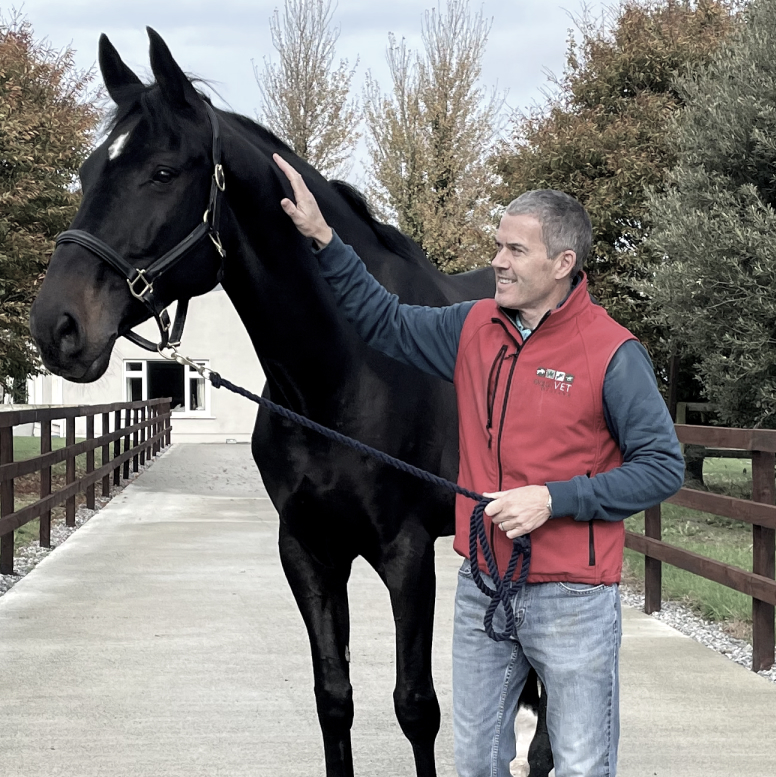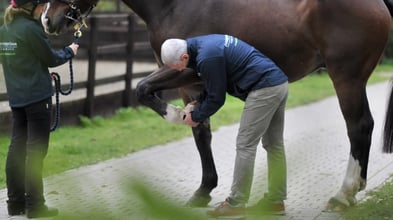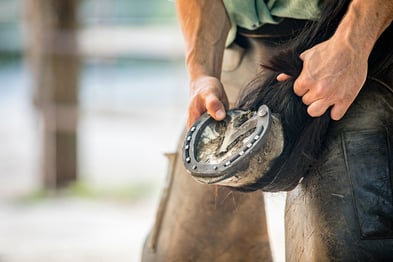Adding clarity to lameness diagnostics
Giorgio Ricardi of Donnington Grove Equine Vets reveals how data-driven gait analysis enhances clinical decisions in complex lameness cases.

“Bring that horse out, I’m going to sleip her!” Marcus Swail has made objective gait analysis part of the everyday, both at his clinic in Ireland and in his work as team vet for the Irish national teams.
A European Pony Championship gold medallist as a young rider, Marcus chose another career path. But his connection to and passion for the sport has shaped his life as a vet.
“I peaked as a competitive rider when I was quite young, so maybe that’s why I decided not to pursue it further. My brother Conor went the other way and has had a very successful showjumping career, so sometimes I wonder”, Marcus laughs.
When asked if he ever considered other career options, the answer is quick and definite. Vet has always been the only other choice. And preferably a competition vet. He goes on to describe a middle-of-the-night emergency call years ago when his pony Calamity Jane got colic. The local vet made quite an impression on a young Marcus.
“It all looked very dramatic and concerning. But the vet was really good at his job. He assessed her carefully, communicated what he thought really clearly, treated her and she got better. He also drove a fast car. I remember thinking “I’d like to do that”.

Lameness is obviously something you come across a lot as a vet?
“Well, all we do all day, every day, at the clinic is look at lame horses” says Marcus jokingly.
“Lameness has always interested me. The idea that you can look at a horse, work out what’s wrong with it and fix it was always attractive to me.”
In any athletic endeavour there will always be issues that impact performance. Horses are no different from human athletes like soccer players or athletic runners in that respect. In any team or group of athletes, there are always going to be some that are in good shape and others who are struggling with some sort of injury.
An overt lameness may be easy to see, but more subtle performance limiting issues can be difficult to detect. That is why Marcus has been interested in objective gait analysis.
How do you use objective gait analysis in your practice?
“Our eye can only see down to about 20 percent asymmetry in a horse’s gait. Someone well trained and experienced can probably improve on that. However objective gait analysis systems don’t have a lower limit on what they can ‘see’ and are therefore better at identifying small things than we are. It is therefore particularly useful in progressing lameness cases that are subtle or more challenging.
Marcus first heard of Sleip during the Tokyo Olympics in 2021, where he bumped into Lars Roepstorff, an experienced veterinary surgeon and professor of equine functional anatomy. Lars is well known among top riders for his extensive research and work on surfaces.
“We got chatting and he told me about this new app, a precise objective gait analysis tool where all you need is a smartphone. I got his e-mail address and when I got back to Ireland I reached out. He put me in touch with the Sleip team for a demo, and here we are!”
Sleiping has become a standard at Swail’s practice, and something he is integrating into his work with the team riders. It helps guide diagnosis and gauge treatment and provides valuable documentation.
What do you like most about Sleip?
“One of the things that I like is that I always agree with it”, Marcus laughs. “The information is always logical. It is always a reflection of what I see, which gives me a great deal of confidence.
There is an element of solving a mystery with every lame horse. I had one come in yesterday and it took me most of the day to figure out what was wrong with him. I used Sleip on him sequentially to finetune diagnosis and treatment.”
Marcus also appreciates the functionality that has been added. Apart from the information gathered when the horse is trotting on a straight line, the past year has seen the addition of a longeing function which analyses how the horse moves on the circle.
“I can imagine that must have been technically very hard to do. They also recently added a functionality where, when you block the horse, it takes the first reading as baseline and then quantifies any subsequent improvement.”
Do you think the equine community is moving towards a future where we are able to work more with prevention than treatment?
“We are now getting team riders to use the Sleip app regularly and send me recordings. That way we can establish a base line of what a horse looks like, then follow up through the season to see if there is any deviation. The idea would be to try to stay ahead of problems, identify and resolve them as early as possible before they become performance limiting.
Having said that, we will always have injuries to deal with. That is the nature of any athletic sport”, Marcus finishes.
Watch the webinar to know in detail how Marcus Swail has integrated gait analysis into daily practice.
“Over the past year, I’ve been in so many situations where I’ve thought of people who would be interested in what they could do with Sleip. I realized I should be spreading it more. Sharing my experiences is my way of doing that. Besides, my presentations tend to be case-based and video heavy and Sleip, being all about motion analysis, lends itself well to that format” says Marcus.

Giorgio Ricardi of Donnington Grove Equine Vets reveals how data-driven gait analysis enhances clinical decisions in complex lameness cases.

We sat down with UK Master Farrier Marc Jerram, who blends traditional skill with modern gait analysis to spot issues early and collaborate with vets on targeted solutions.

At Horsedoc in Denmark, founder Peter Hjuler hosted a lameness webinar with remote orthopaedic check-ups. The results revealed just how often early lameness goes unnoticed — and why detection matters.